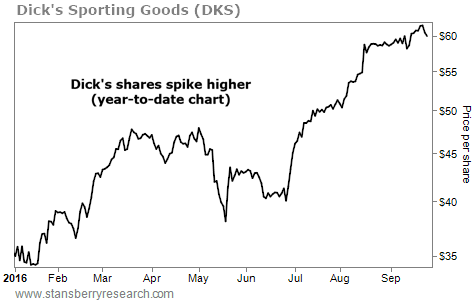| Home | About Us | Resources | Archive | Free Reports | Market Window |
How to Become a Millionaire Using Other People's MoneyBy
Wednesday, September 28, 2016
Rankin Hodgins had humble beginnings.
He was born in 1921 on a farm in Saskatchewan, Canada. He eventually went on to work in insurance and never made more than $65,000 per year.
In 1978, he started investing in the stock market. He began with $200,000 and borrowed another $18,000 from the bank.
By 2012, without ever adding to his account, Rankin's account was worth $6.6 million. That's an 11.8% compounded return.
So how did he do it?
His son Douglas answers this question in a book titled Millionaire Down the Road: Secrets of the Ultimate Tax-Efficient Investor.
Rankin was an ordinary, hard-working fellow. He was not a professional investor. But he did a few things right.
And he did one big thing that was – and remains – controversial...
First, he had a simple way of picking his stocks.
He looked for companies that were consistently profitable and growing all the time. He put a large portion of his portfolio into dividend payers like Canadian banks.
Then he left them alone to take advantage of the power of compounding. If you want to make really big gains, you have to understand how compounding works.
If you earn 20% per year, then $1 becomes...
Note how the gains are back-end loaded. This is because you earn "interest on the interest" of your principal investment as time passes. After 10 years, you've made six times your money. But wait just 10 more years and you've made 38 times your money. That's a huge difference. To leave your stocks alone, you need to suffer through all kinds of economic tides. Rankin's portfolio began when 6% interest rates were standard. Just four years later, they were more than 20%. And by 2012, rates had fallen so low that they had almost disappeared.
There were also the gut-wrenching ups and downs of the market itself. Rankin lost 20% of his portfolio in the 1987 crash. He lost $750,000 in 2001, as the tech bubble deflated. And he was down millions of dollars in the financial crisis of 2008-2009.
But he stood pat. And his stocks eventually recovered.
As his son Doug notes:
Leveraged what? Here we get to Rankin's big controversial secret: He borrowed money to invest. Sometimes he borrowed a lot of money. He was leveraged generally from 30% to 50%.
Consider an example... Let's say you have $100,000 to invest, but you borrowed half of it. That's 50% leverage. Now, interesting things happen when you have 50% leverage. It magnifies your gains as well as your losses.
A 10% gain on that $100,000 means you've made $10,000 on your $50,000. The leverage turns a 10% gain into a 20% gain for you. But a 10% decline becomes a 20% loss on your capital, too.
Of course, this is before interest expense. That's one reason why Rankin likes dividend payers – he used the dividends to pay the interest on his loans.
I can't recommend Rankin's use of leverage to you. If you're not careful, you could be wiped out. Investing in stocks is tricky enough without having to worry about that.
But the debt has another advantage, too: Rankin could deduct the interest expense from his taxes. And since he held on to his stocks, he deferred paying capital gains taxes. This is a tax-efficient way to invest. It's like having a boat with minimal drag, cutting through the water.
Over time, the advantages of Rankin's approach are remarkable. He had more than $5 million in accumulated profits after taxes. Starting with just $200,000. That's incredible.
I love stories like this, because it shows how everyday people can make a lot of money in stocks by doing some relatively ordinary things. Simple stock selection mixed with patience goes a long way.
Rankin added a kicker – he added debt.
In finance, there is a phrase: other people's money, or "OPM." Many wealthy people use OPM to get wealthy, including Warren Buffett. What do you think all that insurance money he collected up front and invested was? It was OPM.
Debt is OPM.
And Rankin's experience as an investor is a case study in why you might think about using some OPM yourself – if you aren't already.
Good investing,
Chris Mayer
Further Reading:
Earlier this year, Steve shared the incredible power of compound interest. "It could mean the difference between retiring in style or not retiring at all," he writes. Read more here: Why You Can't Wait Any Longer.
A $10,000 stake would have turned into $1.7 million in just 38 years following one investment legend. See how that's possible – and learn some important lessons – here: Follow This Legendary Investor's Strategy for Big, Safe Gains.
Market NotesA SIGN OF STRENGTH IN A STRUGGLING SECTOR Today's chart highlights the power of being the leader in an industry...
It has been a tough year for many sporting-goods retailers. Earlier this year, Sports Authority and Sport Chalet – which had more than 500 locations between them – shut down operations. And just two weeks ago, golf retailer Golfsmith filed for Chapter 11 bankruptcy, saying it hopes to reorganize or find a buyer.
Through all of this turmoil, Dick's Sporting Goods (DKS) – the only major national chain in the sector – is thriving. The $6 billion firm has roughly 650 locations across the country. It also owns and operates the Golf Galaxy, Field & Stream, and True Runner chains.
Thanks to disappearing competition, DKS shares have soared. They're up 70% this year and 50% in the last three months alone. Things are looking up for this retailer...
 |
Recent Articles
|
|||||||||||||||



